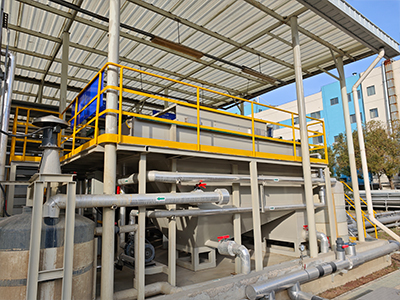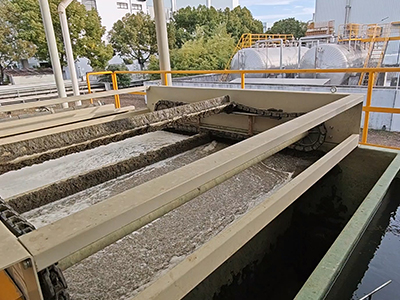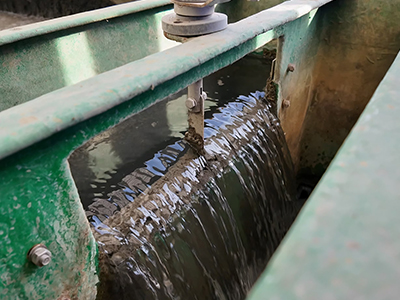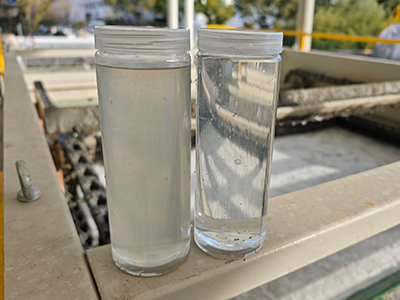Analysis of Acid Pickling and Phosphating Wastewater Treatment Processes and the Application of Key Equipment
Case 2025年2月7日 135
Acid pickling and phosphating are essential processes in metal surface treatment. However, the wastewater generated from these processes contains high concentrations of phosphates, heavy metal ions (such as Zn²⁺ and Fe³⁺), oils, and suspended solids. It is highly acidic and highly polluting, and thus requires scientific treatment to achieve compliance with discharge standards. This article will systematically introduce the treatment process for acid pickling and phosphating wastewater, with a particular focus on the synergistic role of dissolved air flotation and inclined plate clarifiers in the process.
Wastewater Treatment Process for Acid Pickling and Phosphating
- Pretreatment of Wastewater
The wastewater from acid pickling and phosphating first enters a balancing tank, where it is homogenized and regulated in terms of quality and quantity to balance fluctuations in water quality and volume. Given that the pH value of the wastewater is typically between 2 and 4, lime (Ca(OH)₂) or sodium hydroxide (NaOH) is added to neutralize the solution, adjusting the pH to 8-9. This process promotes the precipitation of heavy metal ions (such as Zn²⁺ and Fe³⁺) as hydroxides and creates an alkaline environment for subsequent phosphate precipitation.
- Chemical Coagulation and Sedimentation
After neutralization, coagulants (such as polyaluminum chloride, PAC) and flocculants (such as anionic polyacrylamide, PAM) are added to the wastewater. Through stirring, pollutants are aggregated into larger flocs. This stage can remove most heavy metal hydroxides and some phosphates.
- Dissolved Air Flotation for Efficient Oil and Turbidity Removal
The dissolved air flotation unit plays a core role in this stage:
Principle: The dissolved air system generates microbubbles with sizes ranging from 20 to 50 micrometers. These microbubbles combine with oils, colloids, and fine suspended solids (such as phosphating sludge) in the wastewater to form “bubble-floc” complexes that float to the surface and are removed by a skimmer.
Advantages:
Oil removal efficiency can reach over 90%, preventing oils from encapsulating pollutants and interfering with subsequent sedimentation processes.
High treatment efficiency with a hydraulic retention time of only 15-30 minutes, making it suitable for front-end treatment of high-concentration wastewater.
- Inclined Plate Clarifier for Advanced Solid-Liquid Separation
After treatment by the dissolved air flotation unit, the wastewater enters the inclined plate clarifier, which enhances separation based on the “shallow layer sedimentation theory”:
Structural Features: The clarifier is equipped with multiple inclined plates (angled at 55-60 degrees), significantly increasing the sedimentation area and reducing the settling distance for particles.
Functions:
Secondary retention of residual flocs (such as calcium phosphate and metal hydroxides) remaining in the effluent from the dissolved air flotation process.
Surface loading can reach 3-5 m³/(m²·h), which is 3-5 times more efficient than traditional vertical flow clarifiers, reducing the footprint by 50%.
- Filtration and Advanced Treatment
Stone sand filters or activated carbon adsorption towers are used to further remove trace suspended solids and dissolved organic matter, ensuring that the effluent meets the following criteria: suspended solids (SS) ≤ 30 mg/L, phosphates ≤ 0.5 mg/L, in compliance with the Comprehensive Wastewater Discharge Standard (GB 8978-1996).
- Sludge Treatment
The float sludge from the dissolved air flotation unit and the settled sludge from the inclined plate clarifier are concentrated and dewatered (using equipment such as plate and frame presses) before being disposed of as hazardous waste in accordance with regulations to prevent secondary pollution.
Case Study
Our company treated acid pickling and phosphating wastewater from a machinery manufacturer. The DAF2-020 type dissolved air flotation unit, equipped with microbubble generation technology and an integrated skimmer, offers high automation and reliable operation. By sequentially adjusting the pH for emulsion breaking and adding coagulants, oils and residual phosphates in the wastewater are aggregated through flocculation reactions. The resulting flocs adhere to the large number of microbubbles generated by the dissolved air flotation process, forming a complex that is carried to the surface by the buoyancy of the bubbles. This method can simultaneously remove oils, suspended solids, and phosphorus, achieving rapid solid-liquid separation and safe, reliable operation.
Effluent Quality: After treatment with the dissolved air flotation unit, the oil content in the wastewater is significantly reduced, and the suspended solids concentration is lowered to below 20-30 mg/L, creating favorable conditions for subsequent biological treatment.
Through the application of the DAF2-020 type dissolved air flotation unit, the surface treatment enterprise successfully resolved the challenges of acid pickling and phosphating wastewater treatment, achieving compliance with discharge standards and resource recovery, providing strong support for the sustainable development of the enterprise.




Synergistic Optimization Strategies for Dissolved Air Flotation and Inclined Plate Clarifiers
- Process Configuration
For high-oil-content wastewater: A “flotation-first” mode is adopted (balancing tank → dissolved air flotation → coagulation → inclined plate clarification → filtration), prioritizing the separation of oils to prevent interference with subsequent chemical reactions.
For high-suspended-solids wastewater: A “sedimentation-first” mode is used (balancing tank → coagulation → inclined plate clarification → dissolved air flotation → filtration), removing large metal precipitates first, followed by fine treatment with dissolved air flotation.
- Key Design Parameters
Dissolved Air Flotation: Air saturation pressure of 0.3-0.5 MPa, recycle ratio of 20-30%, bubble density ≥ 5000 bubbles/mL.
Inclined Plate Clarifier: Plate spacing of 50-100 mm, upward flow velocity of 0.3-0.5 mm/s, water distribution uniformity deviation ≤ 10%.
- Operation and Management Tips
Dissolved Air Flotation: Regularly clean the release device to prevent microbubble blockage; monitor the transparency of the saturated air water and adjust chemical dosing as needed.
Inclined Plate Clarifier: Rinse the inclined plate surfaces weekly to prevent mud accumulation between plates; control influent turbidity ≤ 200 NTU to prevent short-circuiting.
Contact Us
- Room 501-5, Building 8, Longdong Avenue 3000, Pudong New District, Shanghai, China
- +86-18918301201
- Grace Xia
- jorsun01@jorsun.com.cn